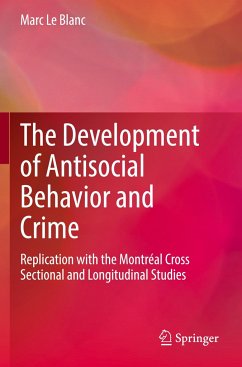This innovative and timely work explores how the developmental criminology paradigm can be applied to understandings beyond criminal careers, to the development of more general antisocial behavior. Importantly, the rich data set from 50-years of cross sectional and longitudinal studies provides replication amongst samples, genders, generations and phases in the life span, from cohorts born in the 1960s, 1970s, 1980s, and 1990s. This work also provides a rich history about the development of the "Developmental Criminology" paradigm, drawing from developmental psychology, and life-course methodologies in Sociology.
With a 50-year, multigenerational longitudinal dataset (the Montreal Two Sample Four Generational Cross sectionnal and Longitudinal Studies -MTSFGCLS) the author explores the mechanisms of official and self-reported antisocial behavior. It provides insights into not only criminal behavior, but other types of potentially problematic behavior, including drug and alcohol use, risky sexual behavior, conflict with authority and other forms of antisocial behavior; as well as their decline across the life-course. By examining the developmental mechanisms and trajectories of these behaviors, the author proposes a multidisciplinary theory to explain these phenomenons.
This work will be of interested to researchers in Criminology, Sociology and Psychology, particularly within the growing area of Developmental and Life-Course Criminology, as well as related fields such as social work, public health and public policy.
With a 50-year, multigenerational longitudinal dataset (the Montreal Two Sample Four Generational Cross sectionnal and Longitudinal Studies -MTSFGCLS) the author explores the mechanisms of official and self-reported antisocial behavior. It provides insights into not only criminal behavior, but other types of potentially problematic behavior, including drug and alcohol use, risky sexual behavior, conflict with authority and other forms of antisocial behavior; as well as their decline across the life-course. By examining the developmental mechanisms and trajectories of these behaviors, the author proposes a multidisciplinary theory to explain these phenomenons.
This work will be of interested to researchers in Criminology, Sociology and Psychology, particularly within the growing area of Developmental and Life-Course Criminology, as well as related fields such as social work, public health and public policy.








